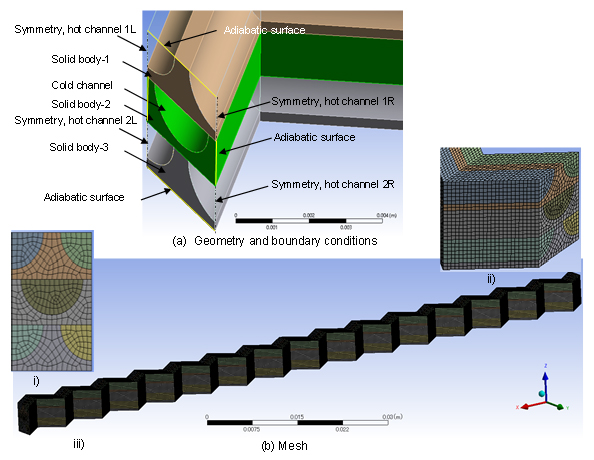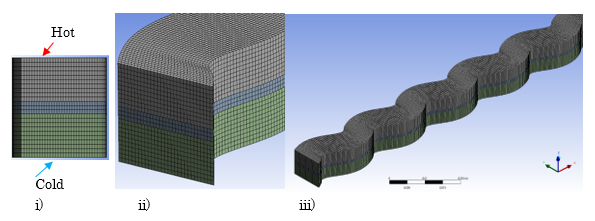Proposal of a heat exchanger used in molten salt fast reactors - Research learned from past knowledge -
2022.08.22
Highlights
- Heat exchangers used in molten salt fast reactors must have a fuel section that is as small as possible and must be of a different type from conventional fast reactor heat exchangers.
- Clarify the heat exchanger heat transfer coefficient when analyzing a heat transport system including a heat exchanger in the system code.
- The heat transfer coefficient was evaluated with a CFD code based on the experimental results using a PCHE heat exchanger with supercritical carbon dioxide as the working fluid.
- By applying the validated heat exchanger model to the system code, the entire heat transport system of the molten salt reactor can now be analyzed.
Summary
An analytical model for a computational fluid dynamics (CFD) code has been validated using the results of past compact heat exchanger experiments conducted at Research Laboratory for Nuclear Reactors in Tokyo Tech, and a heat exchanger for a molten salt fast reactor has been proposed on the basis of the analysis using a similar model. In order to analyze the proposed heat exchanger incorporated into the heat transport system, the relationship between the heat transfer correlation incorporated in the system code and the heat transfer coefficient of the proposed heat exchanger was investigated, and the number of channels to remove 125 MW was evaluated.
Background
One of the features of the molten salt fast reactor is the efficient burning of the transuranic element (TRU). To make full use of this feature, it is necessary to make the volume of liquid fuel contained in the heat exchangers outside the core as small as possible compared to the volume of fuel inside the core. Even if the volume ratio is the same, the irradiation time of 100 days in real time becomes 50 days in reality. If the purpose is only to generate electricity in a nuclear reactor, a conventional shell-and-tube heat exchanger can be used. However, the fuel volume outside the core becomes several times greater than that in the core, and the time during which the fuel is irradiated in the core becomes even shorter. For this reason, we are considering adopting a plate-shaped heat exchanger that can reduce the volume. There is another reason for using this type of heat exchanger. The low thermal conductivity of molten salt fuels results in low heat transfer coefficients, which must be compensated for. Increasing the heat transfer tube length of the heat exchanger improves the overall heat transfer rate, but it is difficult to increase the length of the heat exchanger due to the design of all related equipment installed inside the reactor vessel.
In the past, research on a compact heat exchanger (PCHE) using supercritical carbon dioxide as the working fluid was conducted at the Laboratory for Zero-Carbon Energy (Ex.Research Laboratory for Nuclear Reactors), and in one of the experiments, the heat transfer coefficient and pressure loss were measured using a zigzag flow path with good heat transfer. It was considered that highly reliable heat exchangers could be designed if the numerical model has been validated by analyzing this result with FLUENT, which is a computational fluid dynamics (CFD) code, and if a similar model is used for the newly designed heat exchanger.Results
The author obtained permission to use the data from the professors who had previously conducted the experiment, and created a CFD model of the experimental system as illustrated in Figure 1. After investigating the turbulence model of the FLUENT code, the measured data of heat transfer coefficient and pressure loss were simulated with high accuracy. In addition, the analysis model was also validated using the loss coefficient data of smooth straight pipe measured in the middle of the last century.
From this experimental result, the zigzag flow path has good heat transfer, but results in large pressure loss. Therefore, the author proposed to make channels of the heat exchanger with a sinusoidal curve that can be manufactured by pressing, instead of the expensive etching used in the previous experiment. Figure 2 illustrates the shape of the channel and the model used to calculate the heat transfer element. With this shape, the heat transfer coefficient is almost the same as that of the zigzag, and the pressure loss coefficient can be halved.
Based on the results of the FLUENT analysis, the actual heat exchanger system was evaluated and the heat transfer coefficient obtained from the analysis was applied to the RELAP5-3D system code to evaluate the actual heat exchanger system. Both results are almost in agreement, and the prospect of analyzing the whole reactor heat transport system with the system code was obtained.
In a normal plate-type heat exchanger, each plate is sandwiched using a packing to prevent leakage. Since the proposed heat exchanger handles liquid nuclear fuel, it is necessary to be welded by diffusion welding after pressing a steel plate with a thickness of 0.5 mm, stack the required number of sheets to form a single component. Approximately 100 channels of the flow path shown in Fig. 2 are fabricated by stacking approximately 120 sheets of 0.5 mm plates in between. As a result, approximately 6,000 pairs of heat transfer channels are formed and the heat exchanger can remove 125 MW of heat when the heat transfer length is approximately 4 m.
Fig. 1 Analysis model of heat exchanger experimental system using FLUENT code
i) cross sectional view, ii) side view, iii) overall mesh configuration.

Fig. 2 Adopted sinusoidal curved heat exchanger flow path shape
i) cross sectional view, ii) side view, iii) overall mesh configuration.
Journal information
- Journal :
- Nuclear Engineering and Design, 396, (2022), 111900.
- Title :
- Study of thermal-hydraulics of a sinusoidal layered heat exchanger for MSR
- Authors :
- Hiroyasu MOCHIZUKI
- Affiliation :
- 1) Laboratory for Zero-Carbon Energy, Institute of Innovative Research, Tokyo Institute of Technology
2) Department of Nuclear Science and Engineering Directorate, Japan Atomic Energy Agency

